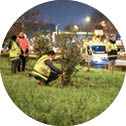A time of change
Over the last 20 years, Paris has been undergoing a radical transformation of its urban model. The aim is to reverse the massive ‘macadamisation’ of the city that began in the 1930s. At a time when 2050 projections show that 70% of the global population will live in cities, Paris recognises that allowing biodiversity to thrive in cities like ours is of paramount importance.
The challenges we face
Some of the environmental challenges we face are long-standing: protecting Parisians from heatwaves, anticipating the risk of flooding, preserving biodiversity, preventing the growing scarcity of water resources and tackling air pollution. But some are new: for example, the recent health crisis has revealed the necessity of reinforcing green spaces in the city, so everyone can have access to a breathing, natural space less than 15 minutes’ walk from home.
Our plan of action
To anticipate and adapt to these numerous challenges, the municipality has implemented several dedicated action plans over the past few years: the ‘Paris s’adapte’ Refreshment Plan, a Resilience Strategy, a Biodiversity Plan and a Tree Plan. By imposing requirements on builders, the local urban plan provides an invaluable tool for shaping the development of tomorrow’s city.


